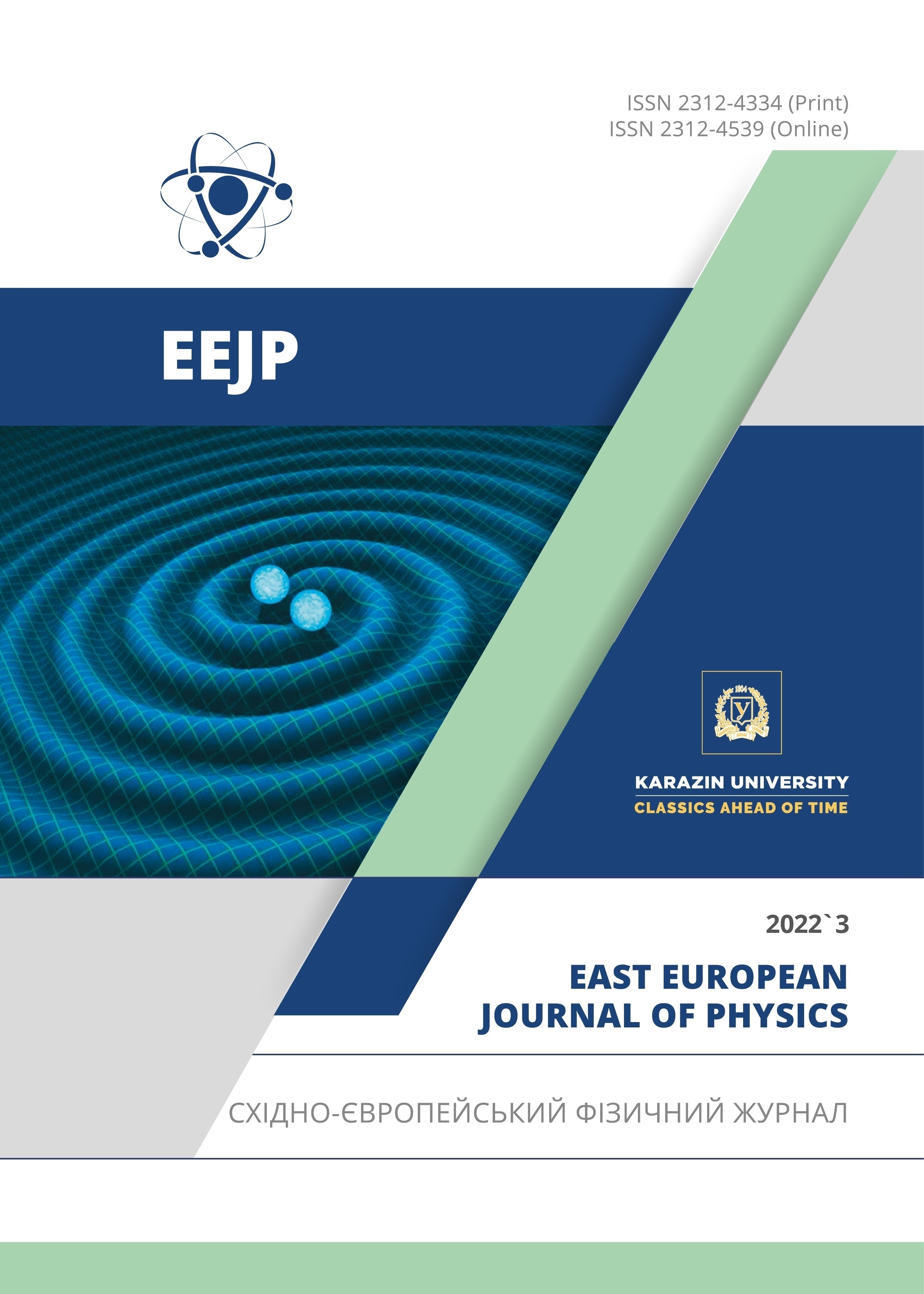Comprehensive Assessment of Biological Substrates of Professional Sick Person Group by Chemometric and Nuclear Physical Methods
Abstract
The article deals with the influence of negative factors of working conditions on the health status of NSC KIPT personnel when working with beryllium. Beryllium and its compounds render a general toxic, allergenic and carcinogenic effect on the organism. The high biological activity and toxicity of Be is due to its chemical activity and penetrating ability. The chronic professional disease such as berylliosis occurs as a result of prolonged systematic exposure on the organism of adverse factors. Elemental analysis of biosubstrates provides important information, that in combination with symptoms and other laboratory parameters, can help in the early diagnostics of physiological violations associated with metabolic disorders and exposure of toxic elements. The blood and hair samples were taken from 28 people, among which 5 patients were selected as a control group, and a group of 23 people were former employees of the beryllium production. The content of chemical elements in the biological substrates (blood and hair) of employees was determined by nuclear-physical methods. An elemental analysis was performed on the analytical nuclear physics complex appliance “Sokol”. The methods based on registration of characteristic X-ray radiation of atoms and g-radiation of nuclei excited by accelerated protons is used. After measurements, data arrays were obtained on the content of 14 chemical elements (N, Na, S, Cl, K, Ca, Ti, Mn, Fe, Cu, Zn, Br, Sr, Pb) in blood and hair. The processing of data arrays was carried out using the principal component method which is related to chemometrics technologies. As a result of the work, an analytical program was composed in MATLAB codes which were used to determine the content of elements in biosubstrates that are most sensitive to changes in external conditions. This made it possible to identify certain groups of patients who have different health state indicators, as well as to see the similarities or differences between patients depending on the different concentrations of chemical elements in the blood or hair.
Downloads
References
V.V. Kosarev, and S.A. Babanov, Professional diseases: textbook, (Vuzovsky textbook, INFRA-M, Moscow, 2011), pp. 252. (in Russian)
E.A. Luzhnikov, Medical toxicology, (GEOTAR-Media, Moscow, 2014), pp. 928. (in Russian)
N. Singh, V.K. Gupta, A Kumar, and B. Sharma, Front. Chem. 5(70), (2017). https://doi.org/10.3389/fchem.2017.00070
A.V. Skalny, Human microelementosis (diagnosis and treatment), (M.: KMK, 2001), 96 p. (in Russian)
S.L. Gerstenberger, C.L. Cross, D.D. Divine, M.L. Gulmatico, and A.M. Rothweiler, Environmental Toxicology, 21, 583 (2006). https://doi.org/10.1002/tox.20221
S.X. Chen, C.L. Wiseman, D. Chakravartty, and D.C. Cole, Int. J Environ. Res. Public Health, 14(3), 277 (2017), https://doi.org/10.3390/ijerph14030277
V.N. Bondarenko, L.S. Glazunov, A.V. Goncharov, A.V. Zats, V.Ya. Kolot, V.V. Kuzmenko, V.V. Levenets, A.P. Omelnik, V.M. Pistryak, V.I. Sukhostavets, and A.A. Shchur, Scientific Vedomosti. Series: Physics, 2(15), 86 (2001). (in Russian)
D.L. Massart, B.G.M. Vandeginste, S.M. Deming, Y. Michotte, and L. Kaufman, Chemometrics: A Textbook, (Elsevier: Amsterdam, 1988), pp. 464.
O. Rodionova, S. Kucheryavskiy, and A. Pomerantsev, Chemom. Intell. Lab. Syst, 213, 104304 (2021). https://doi.org/10.1016/j.chemolab.2021.104304
P. Nomikos, and J.F. MacGregor, American Inst. Chem. Engin. J. 40(8), 1361 (1994). https://doi.org/10.1002/aic.690400809
P. Geladi, K. Esbensen, J. Chemom. 5, 97-103 (1991). https://doi.org/10.1002/cem.1180050206
D. Granato, P. Putnik, D.B. Kovacevic, J.S.V. Calado, R.S. Rocha, A.G. Da Cruz, B. Jarvis, O.Ye Rodionova, and A. Pomerantsev, Comp. Rev. Food Sc. Food Saf. 17, 663-677 (2018), https://doi.org/10.1111/1541-4337.12341
O.E. Rodionova, A.L. Pomerantsev, Kinetics and catalysis, 45, 485 (2004). (in Russian)
H.-L. Koh, W.-P. Yau, P.-S. Ong, A. Hegde, Drug Discov. Today, 8, 889 (2003). https://doi.org/10.1016/S1359-6446(03)02846-0
A.L. Pomerantsev, and I.E. Rodionova, Chemom. Intell. Lab. Syst. 79, 73 (2005). https://doi.org/10.1016/j.chemolab.2005.04.004
L.A. Gribov, Mathematical methods and computers in analytical chemistry, (Nauka, Moscow, 1989), pp. 302. (in Russian)
S. Wold, K. Esbensen, and P.Geladi, Chemom. Intell. Lab.Syst. 2, 37 (1987). https://doi.org/10.1016/0169-7439(87)80084-9
K.H. Esbensen, Multivariate Data Analysis – In Practice 5-th Ed., (Camo, Oslo, 2012), pp. 588.
O.E. Rodionova, and A.L. Pomerantsev, Advances in chemistry, 75, 302 (2006). (in Russian)
A.P. Avtsyn, A.A. Zhavoronkov, M.A. Rish, L.S. Strochkova, Microelementoses human, (Medicine, Moscow, 1991), pp. 496. (in Russian)
M.N. Bates, J.W. Hamilton, J.S. LaKind, P. Langenberg, M. O’Malley, and W. Snodgrass, Environmental Health Perspectives, 113, 11, 1615-1621 (2005). https://doi.org/10.1289/ehp.8197
Copyright (c) 2022 Maryna F. Коzhevnikova, Volodymyr V. Levenets, Oleksandr P. Omelnyk, Andriy O. Shchur

This work is licensed under a Creative Commons Attribution 4.0 International License.
Authors who publish with this journal agree to the following terms:
- Authors retain copyright and grant the journal right of first publication with the work simultaneously licensed under a Creative Commons Attribution License that allows others to share the work with an acknowledgment of the work's authorship and initial publication in this journal.
- Authors are able to enter into separate, additional contractual arrangements for the non-exclusive distribution of the journal's published version of the work (e.g., post it to an institutional repository or publish it in a book), with an acknowledgment of its initial publication in this journal.
- Authors are permitted and encouraged to post their work online (e.g., in institutional repositories or on their website) prior to and during the submission process, as it can lead to productive exchanges, as well as earlier and greater citation of published work (See The Effect of Open Access).








